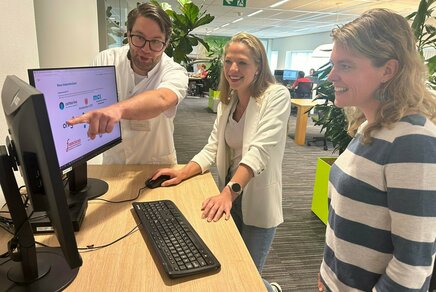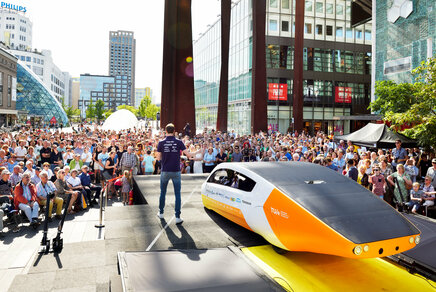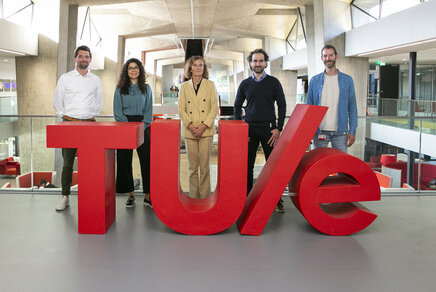Reconstructing living tissue organization
Cas van der Putten defended his thesis at the department of Biomedical Engineering on February 16th.

Millions of people contend with diseases or injuries that affect the cornea, the transparent tissue of the eye that helps to focus light onto the retina, with malfunction of the cornea linked to disorganization of the tissue. Like many tissue types, corneal tissue is made up of cells and extracellular matrix (ECM), a protein network that provides structural support. Corneal ECM is made up of collagen fibers, and cells known as keratocytes ensure they are organized in a particular way. However, serious injury to the cornea can prevent keratocytes from fulfilling their role. In his PhD research, Cas van der Putten looked at the factors that affect how keratocytes are orientated and how this affects the alignment of new collagen.
Tissue in the human body consist of cells and an extracellular matrix (ECM), which is a 3D protein network that provides structural support to cells. Importantly, the arrangement of the two tissue types influences the tissue function.
In the eye, the cornea is transparent and designed to focus incoming light, functions that depend on the precise organization and shape of the tissue. In the cornea, the ECM consists of collagen fibers that are organized in long, anisotropic (not the same in every direction) bundles. Corneal cells, so-called keratocytes, make sure all collagen bundles are orthogonally organized (90° with respect to previous bundles). Unfortunately, millions of people worldwide have diseases or injuries that affect the cornea, many of which are caused by a disorganization of the tissue.
Contact guidance
A possible way to organize keratocytes in an anisotropic manner, and simultaneously stimulate them to produce anisotropic bundles of collagen, is the use of physical structures (like microchannels or fibers) from the direct cellular environment.
It is already known that keratocytes align to anisotropic elements in their ECM, a phenomenon called contact guidance (CG). When researchers align keratocytes using CG stimuli, the newly produced collagen can be deposited along the same direction.
Since it is currently unknown what the ideal CG stimuli are, Cas van der Putten investigated the effect of specific dimensions of the physical, 3D environment on cell orientation. He and his colleagues at the department of Biomedical Engineering found that keratocytes are highly affected by both the width and height of the CG stimuli, and that newly produced collagen follows the orientation of the keratocytes.
Importance of curvature
Van der Putten first developed a way to create anisotropic tissues in the laboratory. However, the produced tissues poorly resembled native cornea. The cornea is an inherently curved tissue, and this curvature is crucial for proper functioning. Besides, the curvature is a property of the tissue that can affect cell behavior, similar to the CG stimuli that can orient cells and collagen.
Therefore, to address the curvature issue, van der Putten next investigated how keratocytes reacted to concave, cylindrical shapes. He observed that fibroblasts (cells present in diseased or damaged tissue) moved around quicker than myofibroblasts (cells typically present in scar tissue).
He also noted that fibroblasts move around quicker on concave substrates than on flat culture substrates. Together, these findings show that not only the dimensions of CG stimuli, but also the curvature of the tissue influence the behavior of cells.
Protocol
To enhance the representability of the laboratory setup, van der Putten developed a protocol to combine CG stimuli and substrate curvature. He used the developed setup to expose keratocytes to the combination of anisotropic CG stimuli (line and circle patterns) and concave curvatures. Again, keratocytes aligned initially according to the CG stimuli.
However, after 7 days, it was observed that keratocytes showed a curvature-dependent organization. The degree of curvature determined whether the cells organized in unstructured clumps (high curvature) or thin layers made from both keratocytes and collagen that are attached to the culture substrate and still followed the CG stimuli (low curvature).
Together, these results show that the manipulation of cell culture substrates is a promising method to steer cell and collagen organization. In the future, these findings may aid in the development of therapeutic treatments where tissue organization and functionality are controlled.
Title of PhD thesis: Reconstructing living tissue organization: A bottom-up bio-engineering approach with a focus on the corneal stroma. Supervisors: Carlijn Bouten and Nicholas Kurniawan.
Media contact
More on Health



Latest news


